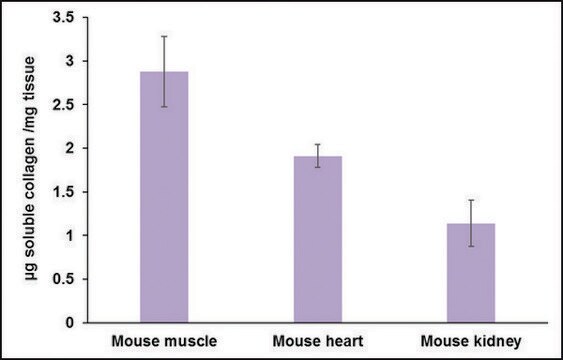おすすめの製品
使用法
sufficient for 100 colorimetric tests
検出方法
colorimetric
関連疾患
rheumatological diseases; cancer; neurological disorders; cardiovascular diseases
保管温度
−20°C
詳細
The new Hydroxyproline Assay Kit, MAK463, is now available! Hydroxyproline ((2S,4R)-4-hydroxyproline, Hyp) is a nonproteinogenic amino acid formed by the enzyme prolyl-4-hydroxylase, which catalizes the post-translational modification of polypeptide proline residues following protein synthesis. In animals, hydroxyproline is found almost entirely in collagen, which contains approximately 12-14% hydroxyproline by mass (the fibrilous protein elastin also contains small quantities of hydroxyproline). Hydroxyproline in tissue hydrolysates is thus a direct measure of the amount of collagen present. Collagen is the most abundant protein in mammals and many diseases are believed to affect collagen turnover, including tumor invasion and metastasis, rheumatoid arthritis, cardiopulmonary fibrosis and muscular dystrophy.
特徴および利点
Perchlorate (PCA)-Free
適合性
Suitable for the estimation of hydroxyproline concentration in tissue homogenates (i.e. muscle, liver, lung, etc.) and human or animal biological fluids (serum, urine).
原理
The classical assay for determination of Hyp is based upon oxidation of Hyp to a pyrrole intermediate, followed by reaction with Ehrlich′s reagent dissolved in concentrated perchloric acid (HClO4). Perchloric acid is a hazardous material that is both toxic and highly reactive, requiring special handling and waste-disposal protocols. The Hydroxyproline Assay Kit (Perchlorate-Free) uses a proprietary acidic developer solution to accurately measure Hyp in tissue and protein/peptidase hydrolysates without the use of hazardous perchlorates. It is a quick and convenient protocol, yielding a brightly-colored chromophore with an absorbance peak at 560 nm. The assay can detect a minimum of 0.05 ug hydroxyproline per well in a 96-well format and generates colorimetric results that are virtually identical to the classical perchloric acid-based method.
シグナルワード
Danger
危険有害性の分類
Aquatic Chronic 3 - Eye Dam. 1 - Met. Corr. 1 - Resp. Sens. 1 - Skin Corr. 1A - Skin Sens. 1 - STOT SE 3
ターゲットの組織
Central nervous system
保管分類コード
8A - Combustible corrosive hazardous materials
引火点(°F)
188.6 °F
引火点(℃)
87 °C
適用法令
試験研究用途を考慮した関連法令を主に挙げております。化学物質以外については、一部の情報のみ提供しています。 製品を安全かつ合法的に使用することは、使用者の義務です。最新情報により修正される場合があります。WEBの反映には時間を要することがあるため、適宜SDSをご参照ください。
毒物及び劇物取締法
キットコンポーネントの情報を参照してください
PRTR
キットコンポーネントの情報を参照してください
消防法
キットコンポーネントの情報を参照してください
労働安全衛生法名称等を表示すべき危険物及び有害物
キットコンポーネントの情報を参照してください
労働安全衛生法名称等を通知すべき危険物及び有害物
キットコンポーネントの情報を参照してください
カルタヘナ法
キットコンポーネントの情報を参照してください
Jan Code
キットコンポーネントの情報を参照してください
最新バージョンのいずれかを選択してください:
試験成績書(COA)
Lot/Batch Number
J K Wenderott et al.
Scientific reports, 10(1), 20423-20423 (2020-11-26)
Obesity-related type 2 diabetes (DM) is a major public health concern. Adipose tissue metabolic dysfunction, including fibrosis, plays a central role in DM pathogenesis. Obesity is associated with changes in adipose tissue extracellular matrix (ECM), but the impact of these
Kara D Wyatt et al.
PloS one, 17(1), e0262832-e0262832 (2022-01-21)
Tumor progression locus 2 (Tpl2) is a serine/threonine kinase that regulates the expression of inflammatory mediators in response to Toll-like receptors (TLR) and cytokine receptors. Global ablation of Tpl2 leads to severe disease in response to influenza A virus (IAV)
ライフサイエンス、有機合成、材料科学、クロマトグラフィー、分析など、あらゆる分野の研究に経験のあるメンバーがおります。.
製品に関するお問い合わせはこちら(テクニカルサービス)




